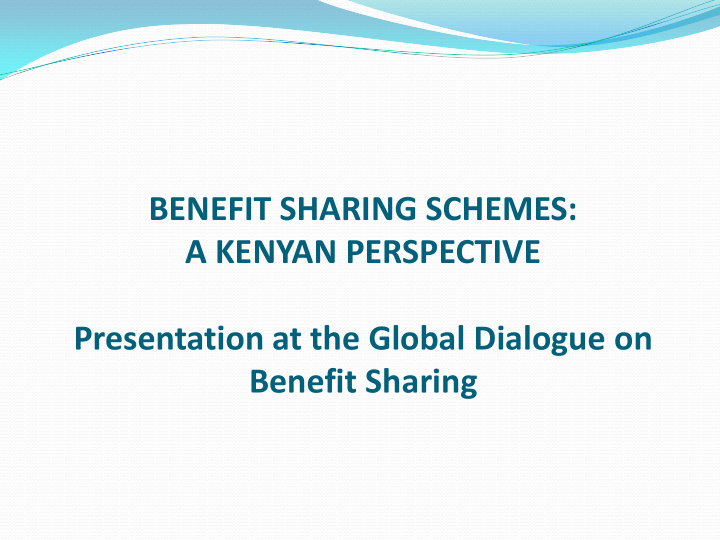



BENEFIT SHARING SCHEMES: A KENYAN PERSPECTIVE Presentation at the Global Dialogue on Benefit Sharing
Out line of the Presentation Policy Context in the country Our understanding of Benefit Sharing Specific examples of Benefit Sharing and a Case study Challenges Opportunities within the country
Requirement for benefit sharing The Constitution of Kenya in Article 69 (1) (a) states that the State shall ensure the equitable sharing of the benefits accruing from the exploitation and utilisation of natural resources. The Constitution requires that all policies and laws should be aligned with it. Kenya's natural resources include forests, land, minerals, water, and wildlife. The policies and laws of these natural resources are being reviewed. In reviewing these policies and laws, we have realised that we do not have adequate information on how to share benefit. One major challenge is how to value the natural resources.
What is BS? – Kenyan Perspective Natural resource management and conservation are associated with costs and benefits which accrue to government, communities and private sector (stakeholders); All benefits accruing from a resource should take into consideration the contributions from various stakeholders. E.g. communities, service providers within governments etc. Benefits to communities could be in the form of money, employment, grazing rights, Water easements, access to wood and non-wood forest products etc. Benefit sharing would then be a process that seeks to compensate the costs borne by various stakeholders and sharing the proceeds arising from their contribution. Costs could be in form of benefits foregone. Benefit flow to various stakeholders should address the issue of equity
Benefit sharing examples in Kenya Forest Sector: Carbon: Kasigau Wildlife Works, Greenbelt Movement, Kakamega Forest Non-wood forest products- grazing, medicinal herbs, honey, biodiversity ( butterfly farming in Kipepeo) and eco-tourism. Through Participatory forest management. Water sector: payments for watershed management in the Lake Naivasha Basin. Wildlife: payments for wildlife dispersal areas (conservation easements), tourism proceeds (Masai Mara). Intellectual Property rights- Indigenous knowledge on bio- prospecting
Kasigau Wildlife Works Carbon Project Covers 210,000 ha with an emission reduction capacity of 1.2 million tonnes of CO 2 equivalent Wildlife Works Carbon (Investor) manages the carbon credits on behalf of the Ranches and community members Communities benefit from carbon resources, employment opportunities, reduced poverty Proceeds from carbon are shared 1/3 (WW), 1/3 (shareholders), 1/3 (community) The allocations were arrived at through mutual agreements. Community are use to fund Projects: non-political, non- religious, positive influence on the region, not personal
Challenges on Developing Benefit Sharing Schemes for Kasigau project Lack of policy framework including guidelines on Benefit sharing Inadequate information on expected proceeds to inform decision making; Unrealistic expectations from some community members Institutional conflict – among various agencies in the country High transaction costs Inadequate local capacity to organize community engagement in REDD+ processes
Opportunities Within the Country Political goodwill and ongoing policy harmonization to align with Constitution; Responsive communities to embrace new ideas; A number of project activities to provide early experiences; PFM efforts in forestry and water sectors; REDD+ and NCCRS opportunities; Upfront payment for environmental services Credit facilities by banks and micro-finance institutions; Ecosystem based small and medium enterprises (SMEs) Creating Partnerships- Banks, Global partnerships etc
Current ongoing efforts Civil society organisations are working closely with the Kenya Forest Service and the Kenya Wildlife Service to come up with a formula for equitable sharing of benefits accruing from natural resources. This work involves introducing policy statements on benefit sharing in the sectoral policy papers being prepared right now. Other sectors that will benefit from this effort include water and minerals.
Recommend
More recommend